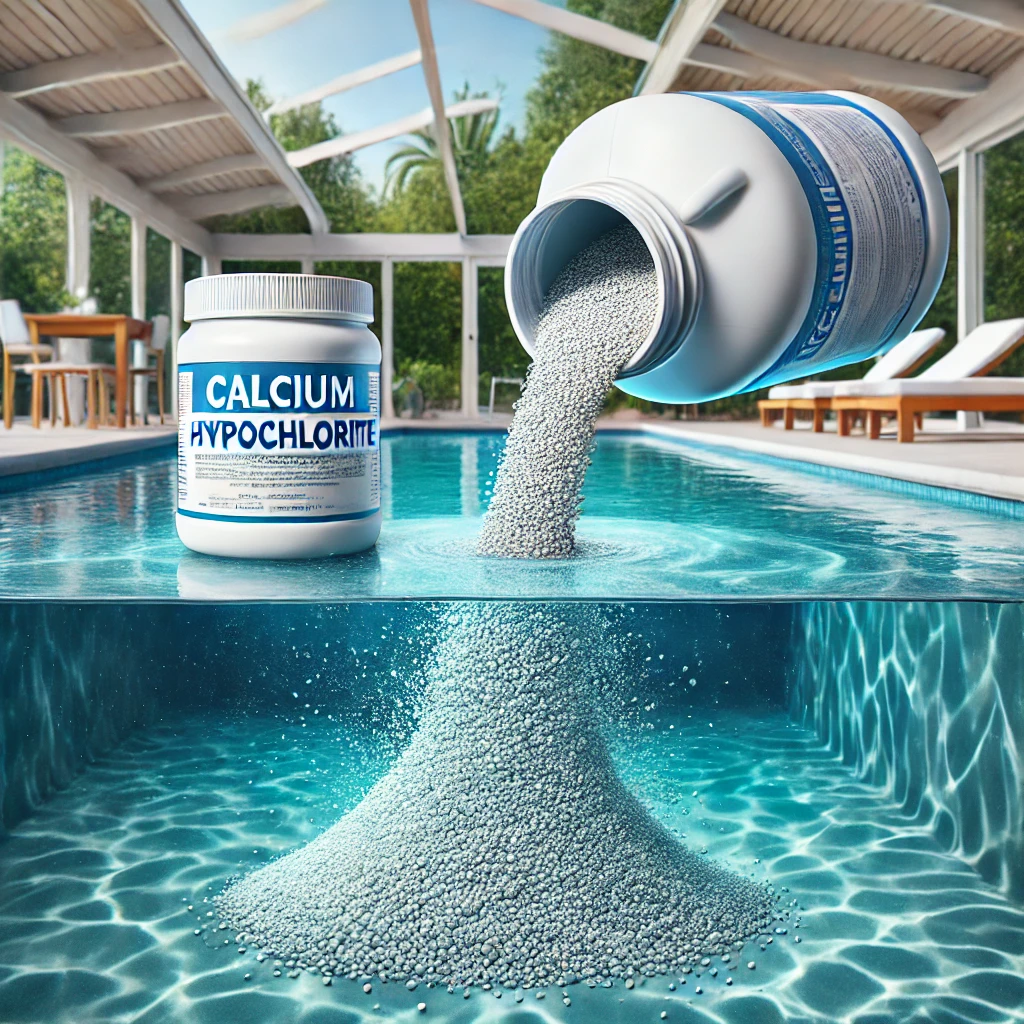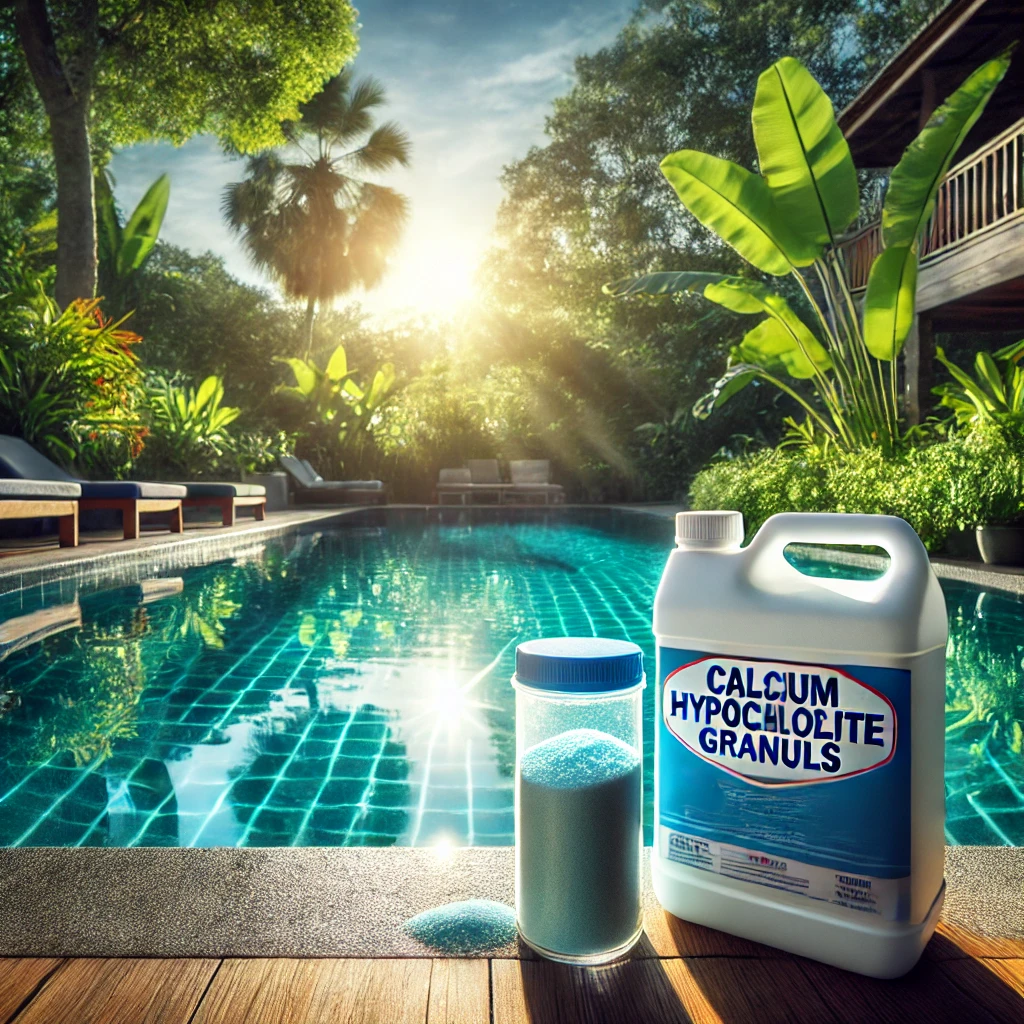Swimming pools require constant attention to stay clean. Bacteria and algae can thrive in untreated water. Fortunately, calcium hypochlorite for pools provides an effective solution. This chemical, widely known as pool chlorine, prevents harmful organisms from growing. In this article, we will explain how calcium hypochlorite works and why it is essential for pool maintenance.

I. Understanding Calcium Hypochlorite
Calcium hypochlorite is a powerful disinfectant. It is often used in both commercial and residential pools. The chemical releases chlorine when mixed with water. Chlorine is a key agent in killing bacteria and algae. Calcium hypochlorite for pools comes in powder or granular form. It is easy to store and handle. This makes it a popular choice among pool owners.
II. How Bacteria and Algae Thrive
Without proper treatment, bacteria and algae can multiply quickly. Warm water and sunlight create the perfect environment. Bacteria can cause illnesses, while algae make the pool slippery and green. Both can make swimming unsafe and unpleasant. A strong disinfectant, like calcium hypochlorite, is needed to combat these threats.
III. The Science Behind Calcium Hypochlorite
When calcium hypochlorite dissolves in water, it releases chlorine. Chlorine then forms hypochlorous acid. This acid attacks the cell walls of bacteria and algae. It disrupts their metabolic processes, killing them instantly. The efficiency of calcium hypochlorite for pools lies in this fast chemical reaction. This process ensures that your pool remains clear and safe.
IV. Why Choose Calcium Hypochlorite?
There are many pool disinfectants available. However, calcium hypochlorite is one of the most reliable. It is affordable, easy to use, and long-lasting. The chlorine levels produced by calcium hypochlorite are stable. This ensures continuous protection against bacteria and algae. Its effectiveness makes it a trusted choice in pool maintenance.
V. Application Process
Using calcium hypochlorite for pools is straightforward. First, measure the correct amount for your pool size. The product’s instructions usually provide guidance. Next, dissolve the calcium hypochlorite in water before adding it to the pool. This step ensures even distribution. After adding it, run your pool’s filtration system. The water circulates, spreading the chlorine evenly. This maximizes the effectiveness of the disinfectant.
VI. Routine Use and Maintenance
Regular use of calcium hypochlorite is necessary to maintain a healthy pool. Most pool experts recommend treating the pool weekly. This helps maintain optimal chlorine levels. Bacteria and algae can return if chlorine levels drop too low. Consistent use ensures the pool remains free of harmful organisms. Maintaining a stable routine with calcium hypochlorite can prevent these problems.
VII. Preventing Bacterial Growth
Bacteria pose serious health risks in pools. Calcium hypochlorite for pools effectively combats bacterial growth. The chlorine kills bacteria within minutes of exposure. Whether it’s E. coli or other pathogens, calcium hypochlorite neutralizes them. Keeping chlorine levels stable prevents bacteria from spreading. Regular testing ensures the pool stays within safe levels.
VIII. Controlling Algae Growth
Algae can make a pool look unappealing. Calcium hypochlorite also plays a critical role here. Algae thrive in warm, untreated water. However, the chlorine in calcium hypochlorite disrupts algae’s growth process. It prevents spores from multiplying. Over time, consistent treatment eliminates algae entirely. This leaves your pool clear and visually appealing.
IX. Safe Handling of Calcium Hypochlorite
While calcium hypochlorite is effective, it requires careful handling. It is a strong chemical and should be treated with respect. Always wear gloves and goggles when handling it. Avoid inhaling the dust or fumes. Store calcium hypochlorite in a dry, cool area. Following these precautions ensures safety for both you and the pool.
X. Balancing Pool Chemistry
Using calcium hypochlorite for pools also involves managing water chemistry. High chlorine levels can cause skin irritation. Low levels may not fully disinfect the pool. Therefore, regular water testing is essential. Pool owners can use test kits to monitor pH and chlorine levels. This ensures that the pool stays balanced and safe for swimmers.
XI. Environmental Considerations
Many pool owners worry about chemical impacts on the environment. Calcium hypochlorite breaks down into harmless byproducts. When used correctly, it poses minimal risk to the environment. It is one of the more eco-friendly pool disinfectants. This makes calcium hypochlorite for pools a responsible choice for pool maintenance.
XII. Choosing the Right Dosage
Correct dosing is key to calcium hypochlorite’s success. Too little will not protect against bacteria and algae. Too much can irritate skin and eyes. Always follow manufacturer instructions for dosing. Dosing depends on the pool’s size and water volume. Proper dosing ensures the pool remains both clean and comfortable.
XIII. Troubleshooting Common Issues
Sometimes, pool owners encounter issues when using calcium hypochlorite. Cloudy water may indicate improper dosing. Algae blooms can result from low chlorine levels. Regular water testing can prevent these problems. Adjusting chlorine levels solves most issues quickly. Always check chlorine levels after heavy rainfall or high swimmer activity.
XIV. Combining with Other Pool Chemicals
Calcium hypochlorite works well with most pool chemicals. However, avoid mixing it with certain products, like liquid acids. This can cause dangerous chemical reactions. Always introduce chemicals separately into the pool. This practice ensures safety and efficiency. Calcium hypochlorite for pools remains effective even when combined with stabilizers or algaecides.
XV. Long-Term Benefits of Calcium Hypochlorite
Over time, calcium hypochlorite helps maintain a healthy pool. Its consistent use prevents long-term bacterial and algae issues. Pool maintenance becomes easier with regular use. The pool stays clean, safe, and enjoyable for swimmers. Calcium hypochlorite for pools ensures that these long-term benefits continue.

XVI. Conclusion
Calcium hypochlorite is a vital tool for pool owners. Its ability to kill bacteria and algae keeps pools safe. Regular use ensures a clean swimming environment. Calcium hypochlorite for pools offers both effectiveness and convenience. For anyone maintaining a pool, it remains a top choice. Following proper handling and dosing guidelines ensures continued success. With calcium hypochlorite, your pool will stay clear, clean, and enjoyable year-round.